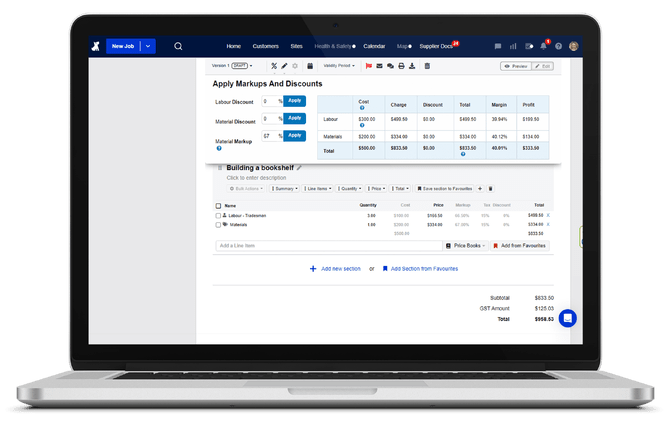In the world of trades, getting your pricing right is crucial for success. Whether you're a plumber, electrician, or builder, quoting jobs accurately can make or break your business. But what's the difference between markup and margin, and why does it matter?
Let's break it down in simple terms.
Markup vs. Margin: What’s the Difference?
Markup is basically adding a percentage to your costs to determine the selling price. For example, if a job costs you $100 in materials and labour, and you apply a 50% markup, you'd sell it for $150 ($100 + 50%).
Margin, on the other hand, is the percentage of the selling price that is profit. So, if you sell something for $150 with a 50% margin, $75 ($150 * 50%) of that is profit.
Here’s where it gets interesting: Markup and margin aren't the same thing! While a 50% markup results in a 33.3% margin ($50 profit on a $150 sale), the percentages aren't directly interchangeable.
Why does this matter? Understanding this difference can prevent you from underestimating costs and ultimately losing money on jobs.
How Fergus Can Help
Now, imagine having a tool like Fergus Job Management at your disposal. Fergus lets you see clearly what your projected profit is for each job. It helps you keep track of your costs, apply the right markup or margin, and ensure you're pricing jobs for profitability.
Accurate Quoting: With Fergus, you can enter all your costs and apply a markup to see the final price. It does the math for you, so you don’t have to second-guess.
Tracking Costs: Keep track of all job-related expenses in real-time. Fergus helps you monitor materials, labour, and any unexpected costs that might pop up.
Profit Margins: Fergus allows you to see your profit margins at a glance. This way, you can ensure each job is not just covering costs but also adding to your bottom line.
Checking Your Profit and Loss
Every month, take a look at your WIP report in Fergus for completed jobs. This will show you how your jobs are performed and where you can improve. Here’s how:
Review Job Costs: Check if your actual costs matched your projected costs. If not, adjust your quoting process accordingly.
Analyse Profit Margins: See which jobs brought in the best margins and why. Use this information to refine your quoting and take on more profitable work.
Identify Trends: Look for patterns in your jobs. Are certain types of jobs more profitable? Are there any recurring issues affecting your margins?
Understanding the difference between markup and margin is crucial for quoting accurately and ensuring profitability. With tools like Fergus, you can take control of your quoting process, track your costs, and monitor your profit margins. So, next time you're quoting a job, remember the importance of markup vs. margin. It's not just about numbers; it's about ensuring your business thrives.
Need help with your quoting process? Book a free discovery call or visit our Facebook page to learn more about how we can support your trade business.





